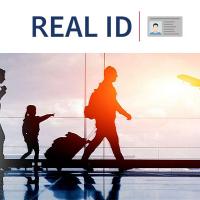[ad_1]
By October 2020, travelers won’t be able to board planes in the United States if they don’t have the correct form of ID.
In the wake of the Sept. 11, 2001, terrorist attacks, the Department of Homeland Security announced a plan to strengthen the security of identification requirements for federal facilities and commercial aircraft. This plan has been slowly unrolling for 12 years, but as of Oct. 1, 2020, the Real ID Act will be effective in all 50 states. After that date, all U.S. citizens will need to have a form of identification that meets the Real ID security standards to pass through airport security.
While more half of U.S. states currently have drivers’ licenses and identification cards available that meet those standards, many states do not, including Missouri, California, and Illinois. The 19 states that are not yet compliant have received extensions to allow them time to update their systems. Even in states that offer Real ID-level cards, travelers who haven’t updated their ID cards since the Real ID system was established may not have qualified IDs.
How to Get Ahead of Real ID
Travelers who are unaware of Real ID’s requirements and fail to obtain updated or alternate forms of identification by the deadline may show up at airports wanting to fly but unable to board. This could lead to mass confusion, long lines, and angry passengers at TSA security checkpoints in the days after the rollout.
Travelers would rather sidestep these complications, so it’s vital to stay abreast of the requirements so that you can share the right information with passengers. Dispense these three bits of advice to travelers to help ensure a smooth transition come October 2020:
1. Have travelers check their IDs.
Just because the traveler’s state offers Real ID-compliant identification does not mean every ID is compliant. Compliant identification has a star on the upper right-hand corner of the license or identification card. Noncompliant IDs are noted with a phrase such as “not for federal identification” at the top. If the traveler’s ID doesn’t have a star and he plans to travel, he needs to either update his license or obtain a TSA-approved form of federal identification.
2. Remind fliers of the steps for license updates.
For each state that adopts Real ID, a time gap exists between the ID becoming available and citizens’ normal license renewal cycles. For travelers to have secure IDs, they’ll have to collect the necessary paperwork and visit a DMV office — possibly before their current licenses are up for renewal. There may be some variety in what is needed to acquire their new license, so remind them to check on what documents are required in their state beforehand.
3. Keep alternate IDs in mind.
If travelers have approved federal identification, they do not have to update their licenses before their renewal date to be able to travel. Those alternate identification options include a U.S. passport or passport card, a military ID, an airline- or airport-issued ID, or a traveler card trusted by the Department of Homeland Security (e.g., Global Entry, Nexus, and Sentri). Travelers just need to take along their alternative TSA-approved form of identification every time they fly on or after Oct. 1, 2020.
Changing the identification system for an entire nation may feel confusing and overwhelming, but you can help travelers find the transition much more manageable. These three simple steps will let travelers fly worry-free any day of any year.
[ad_2]You can read more of the news on source
 Travelsmart
Travelsmart



